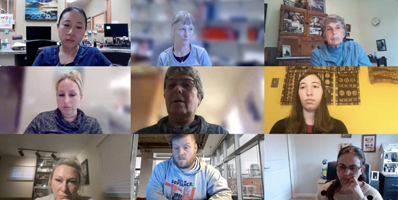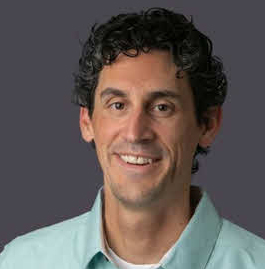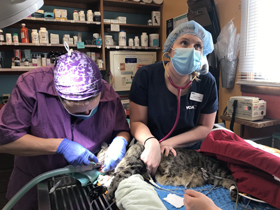VBOG Meeting May 5 2022

Screenshot of Washington state Veterinary Board of Governors meeting
Dozens of stakeholders watched remotely on May 5 as veterinary regulators in Washington state voted to support a private practice group's proposal to start a technician apprenticeship program that includes a pathway to licensure, bypassing American Veterinary Medical Association accreditation.
A move by a private practice to create an apprenticeship for veterinary technicians is spurring consternation in the profession because the program would bypass a national accreditation system.
Washington state's Veterinary Board of Governors last month voted 5 to 2 to support an apprenticeship sponsored by a three-clinic practice group in Central Washington. Critics shook their heads as the vote-in-support was tallied during the remote meeting on May 5.
It now falls to the Washington State Apprenticeship and Training Council to decide if the three-year, 6,000-hour, mostly on-the-job program deserves provisional approval. That review is expected to occur when the council meets Oct. 20.
If approved, the apprenticeship would be the only U.S. program whose graduates could take the Veterinary Technician National Examination (VTNE) and sit for state licensure, even though the program would not be sanctioned by a veterinary medical board or accredited by the Committee on Veterinary Technician Education and Activities. CVTEA was established in 1972 by the American Veterinary Medical Association to develop and implement standards for technician training programs.
The proposed apprenticeship is modest in size; the initial cohort will be three to six people. Circumventing AVMA oversight, however, is a big deal. The prospect of a technician education program without accreditation — a precedent some worry will spark imitators, especially at large corporate practices — has provoked concern and indignation.
That's not the intent of the owners at Cascade Veterinary Clinics (CVC), who say they've proposed the apprenticeship in response to a shortage of technicians that has forced the practice to create local, affordable training options. They contend that more licensure pathways could lead to more credentialed technicians without impacting the quality of education.
The backlash has been intense and surprising, said Dr. Zack Hambleton, a co-owner of CVC who's leading the apprenticeship drive.
"The problem is that the rigor of an apprenticeship program is not being understood by the veterinary community," Hambleton told the VIN News Service. "So the argument that we hear over and over again is that this is just back to the on-the-job training of old. As Washington State veterinarians understand what we're doing, I think they will be excited to support it."
Opponents of CVC's plan include the AVMA, the Washington State Veterinary Medical Association (WSVMA), the national and Washington state veterinary technicians associations and officials with other training programs. The state's support of a non-AVMA-accredited program, they say, will erode efforts to create uniform standards for technicians and negatively impact the profession's ability to attract and retain them.
WSVMA Chief Executive Officer Candace Joy warned the veterinary board that their support of the CVC apprenticeship program disregards the consensus against it.
"In my nearly 20 years of attending nearly every Veterinary Board of Governors meeting on behalf of veterinarians, no other issue before the board has received so much negative attention from across the state and the entire profession," she said during the May 5 meeting.
Reflecting on the board's previous meeting, held last October, Joy estimated that nearly all of the 100 or so people in attendance opposed the CVC's plan. The board also received more than 60 letters from the public in opposition.
AVMA or the highway
Objections to the CVC apprenticeship hinge on the absence of AVMA-CVTEA accreditation, which is available only to programs at institutions recognized by the U.S. Department of Education. Programs at private practices are ineligible for the distinction.
That's a good thing, according to Ashley Byrne, president of the Washington State Association of Veterinary Technicians. "In the absence of this oversight, we feel the participants are not adequately provided with safe and quality education," Byrne told the VIN News Service.
The CVTEA, a 20-member committee of veterinary professionals and educators, evaluates programs in accordance with 11 accreditation standards that pertain to the quality of their facilities and staff, financial capabilities and student performance. Evaluations are periodic and ongoing. There are more than 200 accredited programs in the U.S. and Canada, including five in Washington.
While accreditation is seemingly robust, there is a lot of variation in how well training programs prepare students for the VTNE, according to a 2018 report published in the Journal of the American Veterinary Medical Association. In its review of 204 accredited programs, CVTEA found that 15 had pass rates for first-time takers of below 50%, with one as low as 13%. CVTEA standards require a first-time pass rate of at least 50% in order for an accredited program to maintain its status. The three-year mean pass rate reported in 2018 was 70.31%.

Photo courtesy of Dr. Zack Hambleton
Dr. Zack Hambleton, co-owner of Cascade Veterinary Clinics in rural Washington, is frustrated by a shortage of licensed veterinary technicians in his area. To alleviate the problem, he is working with state agencies to develop an in-house apprenticeship program that will lead to licensure.
In addition, CVTEA has been criticized for failing to ensure the financial soundness of accredited programs. Between 2014 and 2017, 33 accredited programs shut down. The abrupt closure of several for-profit vocational schools left students in the lurch, out the time and money they paid for credits that, in some cases, were nontransferable.
Still, many in the profession believe that accreditation raises the bar for technician education, which engenders credibility and respect. The effort to circumvent the process is a "slap in the face" and "insult," people said in letters and comments submitted to the Veterinary Board of Governors.
"Considering the intense strain on all of us in veterinary medicine right now, emotions are high in any circumstance asking us to risk integrity in a profession we've worked so hard to grow," Byrne said.
If approved, the CVC apprenticeship would be overseen by two state regulatory bodies: the Department of Labor and Industries and its Washington State Apprenticeship and Training Council. Labor and Industries supervises and regulates registered apprenticeships, protecting apprentices and ensuring programs meet requirements set forth in program standards. Separately, the Washington State Apprenticeship and Training Council approves and registers apprenticeship standards.
The Veterinary Board of Governors sets standards for education for veterinary technicians and issues licenses to persons who have passed the VTNE and a post-secondary course approved by the board. At its May meeting, the board was asked to vote on whether it supported, did not support or was neutral on the question of whether to send the veterinary technician apprenticeship standard to the apprenticeship council for approval. Lisa Kelley, a state assistant attorney general, explained in an advisory to the Veterinary Board of Governors that Labor and Industries generally does not forward programs to the apprenticeship council without a vote of support from the relevant regulatory board.
Plans for the CVC apprenticeship program include an internal governance committee comprised of CVC personnel and Dr. Stephen Hines, a former professor of microbiology and pathology at Washington State University College of Veterinary Medicine. Since retiring last year, Hines has helped develop the CVC program.
Existing options fall short
"In the last couple of years, the vet medicine world has been getting busier and busier and harder to keep up with," said Hambleton of CVC. "One of the things that we identified pretty quickly is … we could recruit these really solid vets, but we were having a heck of a time getting LVTs [licensed veterinary technicians]."
Meanwhile, eager veterinary assistants in CVC clinics were struggling to access existing education and training needed to become LVTs. The closest AVMA-accredited technician program is at Yakima Valley College, about a two-hour's drive from CVC clinics. The program website recommends students work outside the program no more than 10 hours per week — a financial commitment most assistants can't afford to make.
Online programs, Hambleton said, "didn't work for our folks."
Hines described online options as a "leaky pipeline." He said: "One of the things I know about online, self-paced programs is the attrition rates are just atrocious. What they won't tell you, and I've asked, is how many drop out along the way."
Not all online programs are self-paced; some follow semesters with assignment deadlines and testing. However, retention information is not easy to come by. The CVTEA requires all programs to submit retention data, but the programs are not required to disclose that information to the public.
Hambleton researched alternatives and discovered that the Washington Administrative Code provides a path to VTNE eligibility for candidates who aren't graduates of AVMA-accredited technician programs.
CVC paired up with SkillSource, a workforce training agency in North Central Washington, to develop the program. The Washington code requires that non-AVMA-accredited programs run for three years, one year longer than required in CVTEA standards. CVC has not released information about the cost of the training to apprentices.
Supplemental instruction — English, biology, chemistry and communications — would be taught at Wenatchee Valley College, which is within a half-hour drive from all three clinics and does not have a technician program. CVC said additional online supplemental instruction is in development.
"Our goal is to partner with an existing online LVT curriculum or with an in-state LVT school," Hambleton said. "Thus far, [they] have been opposed to our proposed program. We hope to continue those conversations once the program is approved by the [state apprenticeship council]."
CVC has expanded and honed its standards and curriculum over the past three years. The current draft includes 300 skills that CVC says align with skills required for AVMA accreditation.
Still, opponents have consistently contended that the CVC program is deficient in skills and study areas. The criticism, which surfaced during last month's Board of Governor's meeting, signaled a contentious exchange when Dr. Andrea Sanchez-Chambers, a board member, drilled for specifics.
"Where are we seeing the gaps?" Sanchez-Chambers asked opponents.
Byrne responded: "When we say there are gaps in there, we mean there are gaps in the accreditation process. Meeting the standard is not enough; accreditation is more than that."
That explanation wasn't clear enough for Kim Morgan, a licensed veterinary technician and board chair. "The board has been asking for specifics in deficits all along," she said. "And this is very much the answer we have gotten … we have not gotten specifics that I am aware of."
Learning the why
CCD apprenticeship

Photo by Jennifer Gunther
Laura James Parsons (right) is one of six students who recently completed a veterinary technician apprenticeship at Community College of Denver. The earn-while-you-learn training program is accredited by the American Veterinary Medical Association.
Opponents emphasize the on-the-job aspect of the apprenticeship, positing that it will fail to provide deeper knowledge and critical thinking built into AVMA-accredited programs.
Dr. James Hurrell, a veterinarian who has worked for more than 40 years in veterinary technician education, opposes the apprenticeship.
"The fundamentals that are learned in a program that is AVMA-accredited sets a very high standard across-the-board on knowledge base," Hurrell said at the meeting. "It would be the same as a nursing program in human medicine. I don't think you want a nurse anesthetist that is on-the-job trained."
Hines pushed back on the idea that CVC would not provide for deep learning or what some called understanding "the why" behind techniques. "There is didactic teaching," Hines said, referring to the 760 hours of classroom and lab education outlined in CVC's plan. "That is exactly what they are trying to do; they are just doing it through a different pathway."
Not everyone is fundamentally against an earn-while-you-learn approach. Some CVC critics point to Community College of Denver, which launched an apprenticeship, registered with the U.S. Department of Labor, for technicians in 2020. The first of its kind in the country, the two-year curriculum is based at the AVMA-accredited academic institution, with on-the-job training taking place at 15 hospitals so far.
Unnecessary solution to the wrong problem
Opponents of the apprenticeship program challenge the notion that expanding training will fundamentally address the technician shortage.
"It's not an issue of people entering the profession," WSVMA's Candace Joy told VIN News. "It's the number exiting the profession due to what we've heard are a variety of conditions that have plagued their profession. This program will not solve the veterinary technician shortage."
The conditions plaguing the profession include inadequate pay, a lack of respect and poor utilization, which is essentially not being permitted or supported to perform the full range of tasks for which technicians are trained.
The new pathway, critics say, will not only fail to address these problems; it will likely exacerbate them by adding confusion and fragmentation to credentialing.
The Veterinary Board of Governors began reviewing the apprenticeship in March 2020. Board chair Kim Morgan listed at the May meeting a few reasons why the board indicated "a level of support for the development of this program" over the years. These included the benefits of a more hands-on, robust clinical experience; a chance to develop a realistic understanding early on of what working as an LVT entails; and the possibility that a model that "involves less debt" will attract students who would otherwise not be able to afford loans and time for the program.
Worth a try
CVC has suggested that it's worthwhile to see if the program can work before deciding it can't.
"One of the things I like about this program is it's small, and it's provisional," Hines said at the May meeting. "And with the crises we are facing right now in this profession, I think we need to be doing experiments. It may or may not work, but we'll learn from it if we try."
In response, several technicians visibly bristled.
"If we allow participants to spend their valuable time on a program that will not help them achieve success, we will have done them a devastating disservice," Byrne told VIN News.
Critics have also raised the concern that approving one program may lead to many.
Hambleton doesn't shy away from suggesting that success could lead to what critics may really fear: the adoption of apprentice programs by large practice chains.
He said program opponents have raised concerns that companies like Banfield or BluePearl might try to run their own apprenticeships.
"If this is a successful program, it could be rolled out to bigger organizations that have the power to do it," Hambleton said. "That is the entire point of this program. I want [opponents] to see that this is a feasible solution to this crisis that we're in."